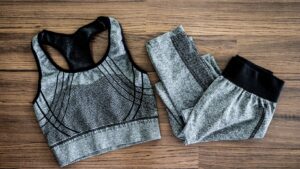Sustainable Fitness Clothing
Traditional fitness clothing aren’t innocent in the worldly predicament. They contribute significantly to environmental degradation with their manufacturing process. Sourcing petroleum for synthetics such as polyester, the most used fabric, incurs high energy and water costs, not mentioning its non-biodegradability.  As an example, one polyester t-shirt spews 5.5kg of carbon dioxide, translating to over double that of its cotton counterpart. Moreover, clothes washing releases 500,000 tons of microfibres into the ocean annually, that’s equivalent to 50 billion plastic bottles.
As an example, one polyester t-shirt spews 5.5kg of carbon dioxide, translating to over double that of its cotton counterpart. Moreover, clothes washing releases 500,000 tons of microfibres into the ocean annually, that’s equivalent to 50 billion plastic bottles.
Sustainable fitness clothing holds the key to curbing environmental impact of fitness apparel. It leverages recyclable materials and ethical manufacturing processes, thereby minimizes its carbon footprint. Consider the transformation of 11 plastic bottles into a t-shirt emitting only 3.3kg of carbon dioxide, less than the aforementioned polyester t-shirt. Use of sustainably-sourced materials, such as organic cotton, bamboo, and even recycled polyester, is a common practice. This alters the narrative, shaping an active lifestyle as a vehicle for sustainability, not just fitness. Sustainable fitness clothing, therefore, stands epitomized as an embodiment of fashion, function, and forward-thinking.
Inside the Making of Sustainable Fitness Clothing
Peeping behind the curtain, let’s unravel the journey of creating sustainable fitness clothing, a confluence of innovative materials and ethical practices. Sustainable fitness clothing begins its voyage as raw materials. Consisting largely of recycled goods, these materials can include anything from discarded plastic bottles to old fishing nets. Post-collection, these waste products receive meticulous cleaning, transforming them into reusable polyester fibers. These fibers, softer and more breathable than virgin polyester, serve as the cornerstone for most eco-friendly activewear. Engineering these fibers into fabric involves an energy-efficient process. Using less water and fewer chemicals than traditional methods, this step aligns with the ethos of sustainability. After the fabric production, these materials are then dyed using environmentally-friendly solutions, continuing to minimize the environmental footprint of the clothes. Once the fabric passes rigorous quality checks, it transitions into cutting and sewing departments. Trained professionals use patterns to strategically cut fabrics, doing their bit to minimize waste.
Once the fabric passes rigorous quality checks, it transitions into cutting and sewing departments. Trained professionals use patterns to strategically cut fabrics, doing their bit to minimize waste.
Integral to the making of sustainable fitness clothing, fair trade practices ensure ethical employment standards throughout the product journey. These practices safeguard workers’ rights and encourage community development, from providing fair wages to safe and healthy working conditions. Certifications like Fair Trade and B Corp distinguish sustainable fitness clothing brands that strictly adhere to ethical standards. Besides, these brands contribute a percentage of their profit towards the wellbeing of the workers and their communities. By embracing fair trade practices, sustainable fitness clothing not only makes a positive environmental impact but also uplifts those involved in its creation, serving as sustainable fashion ambassadors.
The Future of Fitness Clothing: A Sustainable Vision
Stepping into the next era of fitness clothing, sustainability sits at the helm of the vision. Comprehensive transitions are anticipated, addressing key challenges, and fostering fresh innovations. Despite the rise in eco-conscious fitness apparel, accessibility and pricing present significant obstacles. Many individuals find sustainable clothing beyond their price range, creating a tough divide between desiring sustainability and being able to afford it.Sustainable fitness clothing often carries higher price tags than non-sustainable alternatives.  This price variance isn’t indicative of brand greed, but a reflection of the costliness of ethical and sustainable production processes. Manufacturing methodologies, involving recycled materials and fair-trade workings, are intrinsically expensive. By contrast, mass-produced, ‘fast-fashion’ fitness clothing frequently exploits labor and resource economy, offering customers lower prices.
This price variance isn’t indicative of brand greed, but a reflection of the costliness of ethical and sustainable production processes. Manufacturing methodologies, involving recycled materials and fair-trade workings, are intrinsically expensive. By contrast, mass-produced, ‘fast-fashion’ fitness clothing frequently exploits labor and resource economy, offering customers lower prices.
Combating this, progressive fashion brands are stepping up efforts to bring affordable, eco-friendly fitness clothing to the market. They’re investing in research to lower production costs, thereby making sustainable options accessible to a wider audience. A sustainable future for fitness clothing heralds a series of innovative advancements. Several brands are setting new benchmarks in sustainability, paving the way for smart, eco-friendly inventions in attire. Breakthroughs include development of fabrics from unusual bio-based sources, such as algae, coffee grounds and mushrooms. A prime instance is the advent of biodegradable fitness wear, offering a solution to clothing waste issue, with garments that naturally decompose after their life cycle. Another innovative trajectory features fitness clothing with self-cleaning properties. This tech-infused apparel requires fewer washes, hence ssaves water, reduces chemical detergent use and upholds garment longevity.




